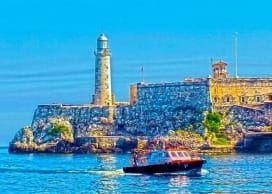
Havana ephemeris. June 4
1932. Lisandro Otero González is born in Havana.

With the passing of his existence, he studied literature at the Sorbonne University in Paris, and was also a student at the School of Journalism and the Faculty of Philosophy and Letters of the University of Havana. He also graduated as a journalist from the Manuel Márquez Sterling School.
Writer, diplomat and journalist, he was the author of novels and essays, translated into fourteen languages, as well as a corresponding member of the Royal Spanish Academy and the North American Academy of the Spanish Language as well as director of the Cuban Academy of Language.
From the political point of view, he actively participated in the July 26 Movement that led the opposition to the Batista dictatorship. After the triumph of the Revolution in 1959 he held positions of responsibility in the country's intellectual sphere.
He was editor-in-chief of the newspaper Revolución, director of the Cuba and Revolución y Cultura magazines, executive of the Union of Writers and Artists of Cuba, even at one stage he was President of this organization, and was part of the Board of Directors of the House of the Americas.
Among the awards and distinctions received for his professional work are: National Literature Award, Rómulo Gallegos Award from Venezuela, National Journalism Award from Mexico, Juan Gualberto Gómez National Journalism Award, Medal for National Culture, Raúl Gómez García Medal and Felix Elmuza Medal.
His death occurred in Havana on January 3, 2008.
1966.- The Coppelia ice cream parlor begins to provide services, an emblematic name of a character from a classic ballet. It is the largest existing ice cream parlor in Cuba.
It covers the area between streets 21 and 23 as well as K and L in Vedado, Plaza municipality.
It is very close to the beginning of what is commonly identified in the Cuban capital as La Rampa, the slope of 23rd Street that extends from L Street to Avenida del Malecón, which is one of the most famous and crowded places from Havana.
Also close to the Coppelia ice cream parlor is the Habana Libre hotel, the Cuban Institute of Radio and Television, the Yara cinema and the monument erected to Quixote de América.
On the site where Coppelia is located, the Reina Mercedes hospital had been there since 1886, which remained active until 1954 when it was demolished with the intention of building another hospital there.
Later it was thought to build a 50-story building there, but the project never materialized.
After the triumph of the Revolution in 1959, the INIT Park was created there, acronym for the National Institute of the Tourism Industry.
It was a tourist promotion pavilion in which small mountains, an artificial lake, a floating stage, fountains, a cafeteria, a bar and a restaurant for five hundred people were reproduced.
Subsequently, the INIT park was deactivated and some of its facilities served as headquarters for the Nocturnal Recreational Center.
In 1966 the construction of the ice cream parlor was conceived. The architect Mario Girona drew up the sketch of Coppelia with great promptness. It had the collaboration of the architects Rita María Grau and Candelario Ajuria.
The structural calculation of the work was in charge of the engineers Maximiliano Isoba and Gonzalo Paz.
In the Coppelia ice cream parlor there are five outdoor areas and a two-story circular central building.
In its lower part it has a large court divided into three parts and on the upper floor there are several rooms.